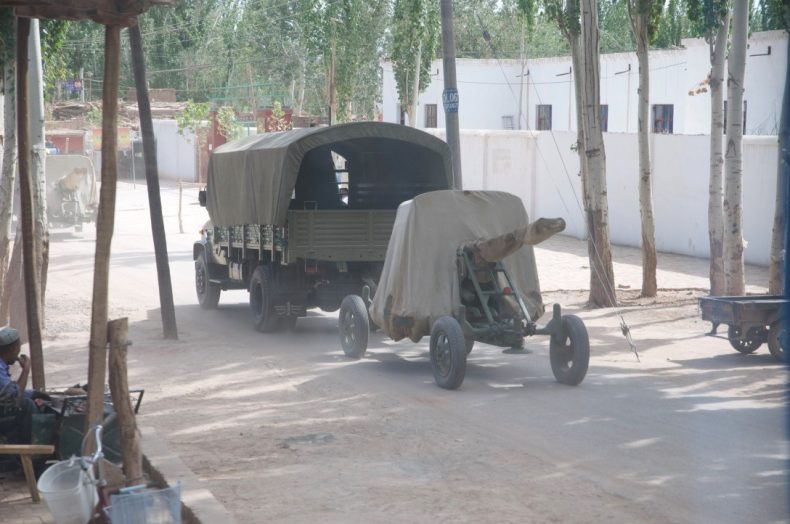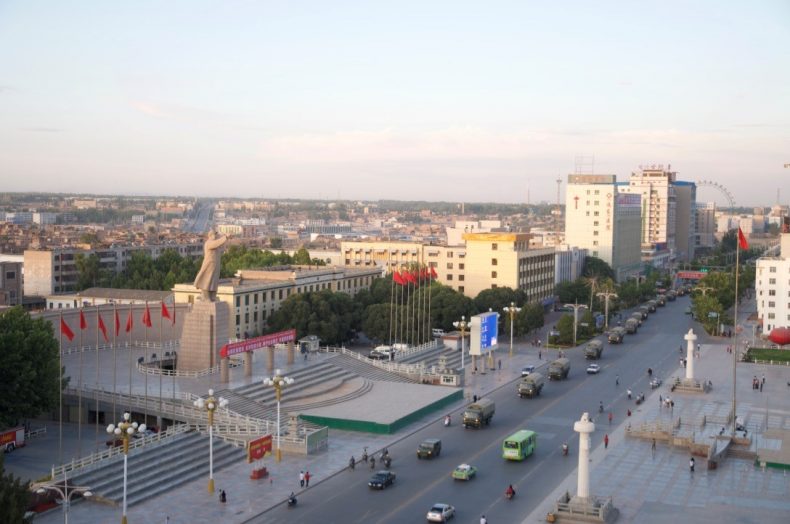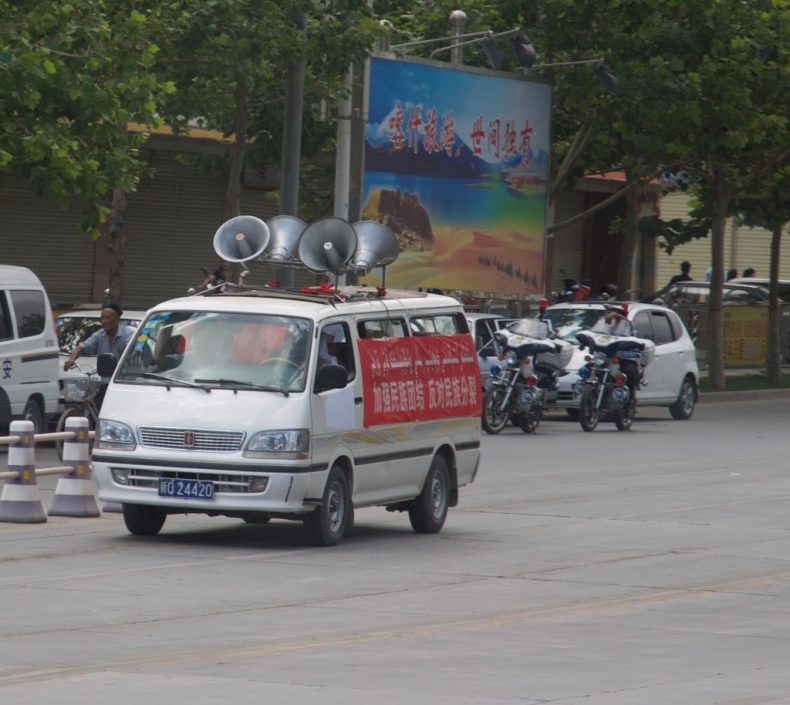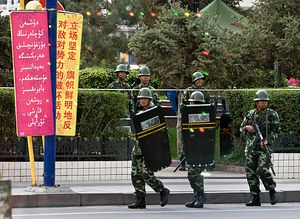Ten years ago this month, Xinjiang experienced deadly riots caused by ethnic unrest, one of many turning points in the Chinese government’s increasingly draconian rule over the region home to the Uyghur ethnic group. I was in Xinjiang at the time as a tourist on break from a study abroad program in eastern China, and our group ended up being one of the last to remain in the region. Looking back, it was impossible to know then that the Chinese government would eventually detain an estimated 1.5 million people in what senior U.S. officials have described as a “systematic campaign of oppression” that includes the “mass imprisonment of Chinese Muslims in concentration camps.” Yet the response I witnessed by the Chinese government with force and oppression did chart the way forward for its worsening treatment of Uyghurs and other minority groups.
The events of July 2009 started far away in the southern Chinese province of Guangdong several weeks earlier. Male Uyghur factory employees were accused of sexually assaulting female coworkers from China’s majority ethnic group, the Han, leading to clashes between the two ethnic groups that left two Uyghurs dead. Although the link is unclear, Uyghurs back in Xinjiang’s capital of Urumqi began protesting on July 5 calling for an investigation into the Guangdong incident. The protests started peacefully, but they turned into violent clashes between Uyghur and Han residents of the city, with Chinese paramilitary called in to quell the riots. These Uyghur protests spread to other cities throughout the region, and while foreign journalists were allowed to visit and report on the tensions, the full scale of the protests has never been revealed. The official death toll steadily rose, officially reaching 197 people, mostly Han, with 1,600 wounded and 1,000 arrested. Twelve Uyghurs were killed by Chinese security forces during the riots and another nine were executed several months later. In reality, it is unlikely the true scope of the riots and casualty figures will ever be known due to a lack of independent oversight.
My tour group was far away from the chaos in Urumqi, but quickly experienced the Chinese government’s crackdown throughout Xinjiang. Our travel plan was to drive across the region, starting at the China-Pakistan border (an area disputed with India) and ending in Urumqi, traveling roughly 1,000 miles over our 10-day trip. After arriving on July 4, 2009 in Kashgar, the region’s second largest city and hub of Uyghur life, we toured the city’s famous market and old city on July 5, the day the riots began in the region. We did not see any protests or sense any tensions. The old city was already in the process of being “rebuilt” for “safety,” reflecting an early but quite literal re-engineering of Uyghur society.
On July 6, we headed to the Chinese border with Pakistan, planning to picnic there. The first thing that seemed out of the ordinary was the fact that we were turned back from the border checkpoint. At least back then, China didn’t actually have full control over the border region, so there was an intermediary border checkpoint set perhaps two hours back from the border. Half of our tour group had already passed through this checkpoint when the border guards received a phone call from Beijing, and told the group to go back — they were closing the border. We returned to the small town we were staying in, Tashkurgan, curious as to what was happening, only to find the internet in our hotel wasn’t working. At first, we thought it was simply a problem with the hotel’s internet service but eventually learned it affected all of Xinjiang — the first time China had ever shut down the internet to a whole area since the country connected to the world wide web in 1994. One of our classmates had spent time in Urumqi and heard from a friend there that there were protests, but we certainly did not grasp the gravity of the situation at that point.

Towed artillery on the move outside Kashgar on July 7, 2009. Photo by Nathan Beauchamp-Mustafaga.
As we traveled through the region, we and the rest of Xinjiang were gradually cut off from the world. After losing the internet, we also lost texting and then international calling, as the Chinese government isolated the region so it could suppress the protests. This isolation made it difficult not only for us to stay in touch with our families watching events unfold back home in America, but for outsider observers and journalists to get an accurate sense of what was happening on the ground. The region’s information isolation did not end after the protests—international calling was only restored in January 2010 and the internet was out until May 2010.
We never directly experienced the protests, but certainly witnessed the Chinese government’s efforts to suppress them and restore control of the region. When we returned to Kashgar on July 7, we saw artillery and People’s Armed Police troops moving in. Kashgar itself was a completely different city than we had visited two days earlier, with most of the shops closed and few people on the streets. Two of our classmates were briefly detained for taking photos of the military presence, but were released. We heard protests at night in at least one town we stayed in along the way, and we were barred from Aksu on July 9 as the government put down what appeared to be a second and previously unreported protest after Chinese media claimed the town was pacified. There were many impromptu checkpoints along the major highways, and we would all have to get off the bus to have our passports inspected one by one.

A long line of personnel carriers transport paramilitary troops into Kashgar on July 7, 2009 through the main public square. Photo by Nathan Beauchamp-Mustafaga.
The power of the Chinese Communist Party (CCP) spin machine was already evident back then. When we finally reached Urumqi on July 11, we were upgraded to the nicest hotel in the city and welcomed by the region’s minister of tourism. Much to our surprise, there was a TV crew waiting for us as we got off the bus, and many members of the group were interviewed. Even then, it was odd that they did not want to speak with the Chinese American students, nor did they want to speak with one classmate who spoke Uyghur or anyone wearing Uyghur clothing. They did not really even have much interest in those of us who spoke Mandarin Chinese. Instead, the TV crew focused on a tall, white classmate who was wearing a baseball t-shirt: for a Chinese audience, he was quintessentially American. In retrospect, the intent was clearly to showcase the Chinese government’s successful efforts to restore stability to the region, evidenced by a bunch of young American tourists. The TV crew turned out to be from CCTV and our group was broadcast on Chinese nightly news for a domestic audience. But what we later saw on TV was not what my classmate had actually said: my classmate’s praise (in English) for how the various ethnic minorities we met traveling in rural Xinjiang — Uyghurs, Kazakhs, Tajiks, among others — got along well was translated into Chinese as lauding the ethnic harmony between the majority Han and minority Uyghurs. Even though most of the stores in Urumqi were still closed, with few people on the streets and a very heavy police presence, everything was portrayed as back to “normal.”
Staid CCP propaganda has long been a fixture of Chinese life, but the rapid propaganda response was evident on the ground in Xinjiang. In Tashkurgan even before the riots, large signs on top of government buildings read “liberate [your] thoughts, seek truth from facts” and “advance with the times, pioneer and innovative,” while worn billboards extorted, “development is the first priority, stability is the first responsibility.” When we returned to Kasghar after the riots had started, we realized that the propaganda attached to the large statue of Mao Zedong had changed from a sign welcoming a tour of famous authors to “strengthen national unity, oppose ethnic division, maintain social stability, and build a beautiful home.” Vans were driving around Kashgar blaring propaganda with signs reiterating the point: “strengthen national unity, oppose ethnic division.” By the time we reached Urumqi, the propaganda posters were already up, similarly reminding residents that “National unity is the lifeline of the people of all nationalities” and urging “all ethnic groups to work together to achieve common prosperity and development.”

A van in Kashgar on July 7, 2009 blares propaganda while the red sign reads, “strengthen national unity, oppose ethnic division.” Photo by Nathan Beauchamp-Mustafaga.
After 10 years, what has stayed with me is the kindness of the people we met in Xinjiang in these difficult circumstances. In Tashkurgan as we wandered about town after being turned away from the border, we met a Tajik woman who graciously invited us into her home to chat and eat. The conversation was not easy, with translation from English to Uyghur to Tajik and back again, but our host kindly continued for over an hour. When we were barred from Aksu, we were diverted up the road to Kuqa, where we happened upon a Uyghur wedding. They welcomed us with open arms, inviting us to dance and chat with them.
In retrospect, it was a difficult time to celebrate much of anything in Xinjiang. The air was clearly tense, though it was not always obvious at the time. Despite the program’s language pledge, our local tour guide refused to speak Chinese with us shortly after the trip began and switched to excellent English. We welcomed this relief from learning Chinese, so we overlooked the fact that she was, in her own quiet way, protesting the Chinese government’s oppression of the Uyghurs. We spoke with several people who relayed that they were barred, formally or in practice, from undertaking the hajj to Mecca, which was especially difficult for older family members who felt the obligation to do so.
Events since 2009 have evolved at a dizzying pace. Violence in the region has flared off and on, including in 2013 when 35 people died in clashes in Xinjiang the Chinese government claimed were instigated by Uyghur extremists. A 2014 knife attack in the Kunming railway station in Yunnan province, similarly by purported Uyghur extremists, further exacerbated tensions. In 2016, the central government installed a new party secretary, Chen Quanguo, to rule the region. Chen brought his tough tactics from Tibet, another restive region in China, and oversaw a massive expansion of policing, hiring more than triple the number of security personnel with a focus on controlling all the way down to individual neighborhoods. This crackdown spurred many Uyghurs to migrate to Turkey and elsewhere, though the Chinese government is now pressuring many countries to either monitor or even return these refugees back to China.
Today, 10 years on, Xinjiang is a dystopian nightmare of omnipresent policing and even preventative arrests. The scale of China’s crackdown is hard to understate, both in scope of people affected and tools utilized by Beijing (one news aggregator for those seeking to learn more runs 529 pages). Most prominently, in 2016 Chen began to detain ethnic minorities in “de-extremification” political re-education camps. Experts currently estimate 1.5 million people are held in the camps, including foreign citizens. While China initially denied these facilities existed, due to dogged journalism and academic research, it now describes them as “vocational” institutions and offers limited access to foreign journalists, which find the detainees do not receive the rights and benefits claimed by the Chinese government.
Beyond these camps, minority residents of Xinjiang are subjected to daily and far-reaching surveillance, including ubiquitous facial recognition technology, routine scans of cell phones, and even DNA testing without meaningful consent. All this data is fed through a centralized system that uses an algorithm to identify people that it deems worth of further investigation. Reports suggest that perhaps 10 percent of all Uyghurs in Xinjiang have been detained, including upwards of 40 percent in some villages, for a host of reasons including simply having banned applications on their phone, such as WhatsApp, to talking with overseas relatives.
Xinjiang is just one, though surely the most troubling, example of the trajectory of China under CCP General Secretary Xi Jinping. Xi has doubled-down on his predecessor’s obsession with social control through “stability maintenance” all across China, but especially targeted at distinct but distrusted social groups, such as ethnic minorities or even feminists. The tools and methods for control we see in Xinjiang are slowly spreading to the rest of China as part of what some call “high-tech illiberalism.” While it now feels difficult to imagine facial recognition in the glitzy modern cities of Beijing or Shanghai, it was also difficult to imagine such a fate would befall the people of Xinjiang back in 2009.
Nathan Beauchamp-Mustafaga is a policy analyst based in Washington, DC.
































